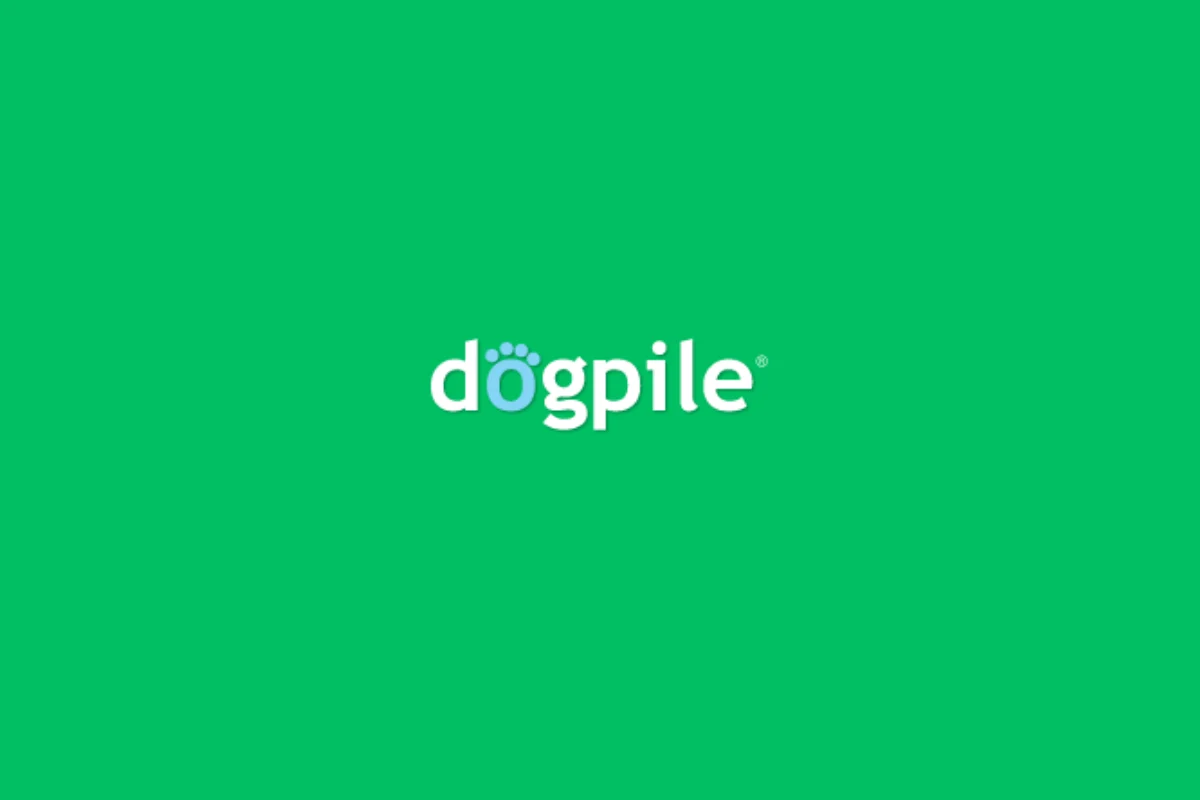While Google dominates search engine usage, it’s not the only option, nor always the most efficient. For professionals seeking broader data coverage or less personalized tracking, meta-search engines offer unique advantages.
Among them, Dogpile stands out for its ability to consolidate results from multiple search engines into one unified interface.
Originally launched in the late 1990s and now operated by System1, Dogpile is still relevant in 2025 due to its technical simplicity and utility in diverse research environments.
This review will explore Dogpile’s core mechanisms, standout features, practical use cases, and limitations, providing a clear picture of its place in a modern search strategy.
Table of Contents
What Is Dogpile?
Dogpile is a meta-search engine that aggregates results from several primary search engines, including Google, Bing, Yahoo!, and Yandex, then merges them into a single, curated list.
This multi-source approach aims to deliver more comprehensive and less biased search results by pulling data from competing algorithms and databases.
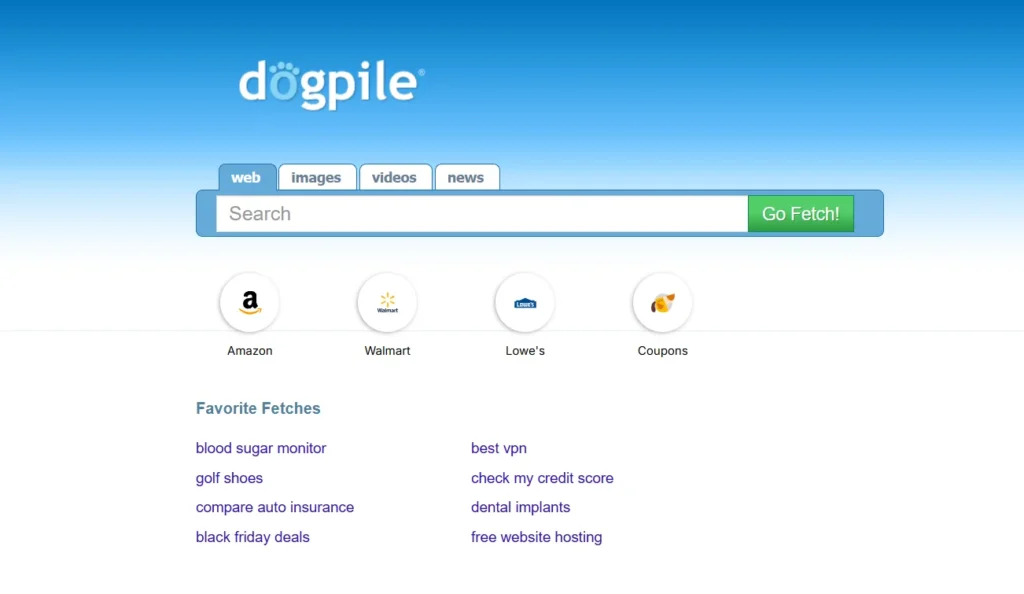
Rather than developing its own indexing system, Dogpile operates as an intelligent intermediary. It filters duplicate entries, prioritizes the most relevant listings, and attempts to improve user efficiency by reducing the need to perform the same query across multiple engines.
Launched in 1996 and relaunched under System1’s ownership, Dogpile has steadily evolved to remain functional in today’s digital landscape. Though it lacks Google’s ecosystem of services, it compensates with a clean interface and lightweight architecture.
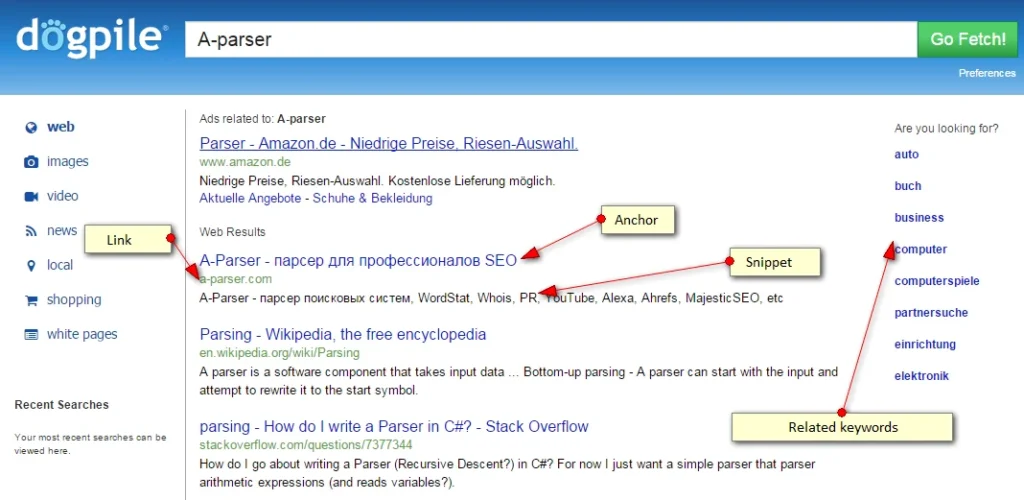
For professionals seeking supplemental search perspectives or trying to minimize personalization bias, Dogpile can be a valuable part of a diversified search workflow.
Key Features
Dogpile’s core utility lies in its ability to consolidate web results, but several supporting features enhance its value for professional and technical users.
- Meta-Search Aggregation: Dogpile pulls results from leading engines like Google, Yahoo!, Bing, and Yandex. This layered querying system enhances recall by displaying a broader spectrum of indexed pages in one place.
- Smart Ranking and Duplicate Filtering: Aggregated entries are scored, ranked, and deduplicated using Dogpile’s own algorithm. It reduces redundancy while highlighting what multiple engines agree to be the most authoritative sources.
- Advanced Search Filters: Users can refine results by file type, date, category (such as video, image, news), or language. This is useful when targeting region-specific or format-based information retrieval.
- “Best Of” Box: Displays quick-answer boxes for commonly asked questions, similar to featured snippets but curated across multiple engines.
- Fuzzy Logic and “Sounds Like” Matching: Incorporates phonetic matching to catch misspelled or closely related keyword variants. It is beneficial in voice search contexts or non-native spelling patterns.
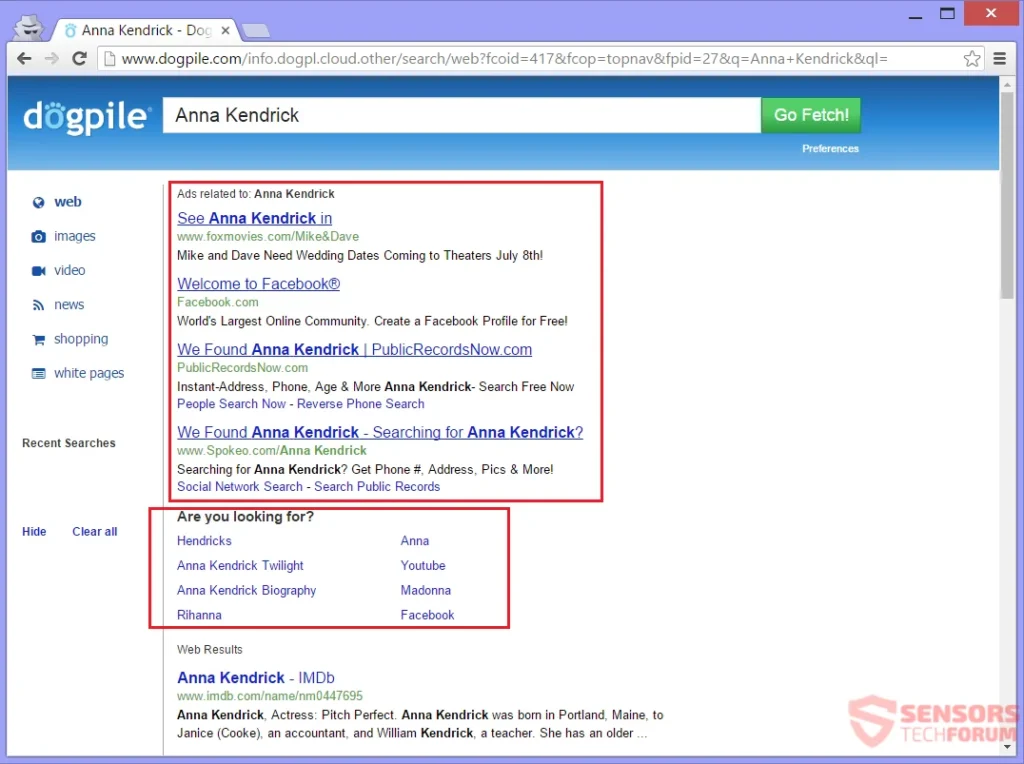
- Homepage Customization and Themes: Offers minor UI personalization, allowing businesses to configure Dogpile as a start-page with preferred visuals and layout.
These features make Dogpile function as a filter and enhancer of search quality, especially when used for technical research, reputation monitoring, or comparative SERP analysis across engines.
Benefits of Using Dogpile
Dogpile isn’t a mainstream choice in 2025, but its meta-search foundation still delivers technical value in specific business and research contexts. Below are the primary advantages worth noting.
Aggregated Results Across Multiple Search Engines
Dogpile pulls results from Google, Bing, Yahoo!, and more. It reduces over-reliance on one algorithm and increases the diversity of data sources in a single search.

Lower Algorithmic Bias and Filter Bubbles
Unlike engines that rely on personalization, Dogpile offers a more neutral snapshot of web content. It helps avoid confirmation bias and provides a broader range of perspectives, which is especially important in competitive analysis.
Minimal Interface and Fast Performance
Its stripped-down interface focuses purely on the search task. Without auto-playing media, Dogpile loads quickly and performs reliably on slower connections.
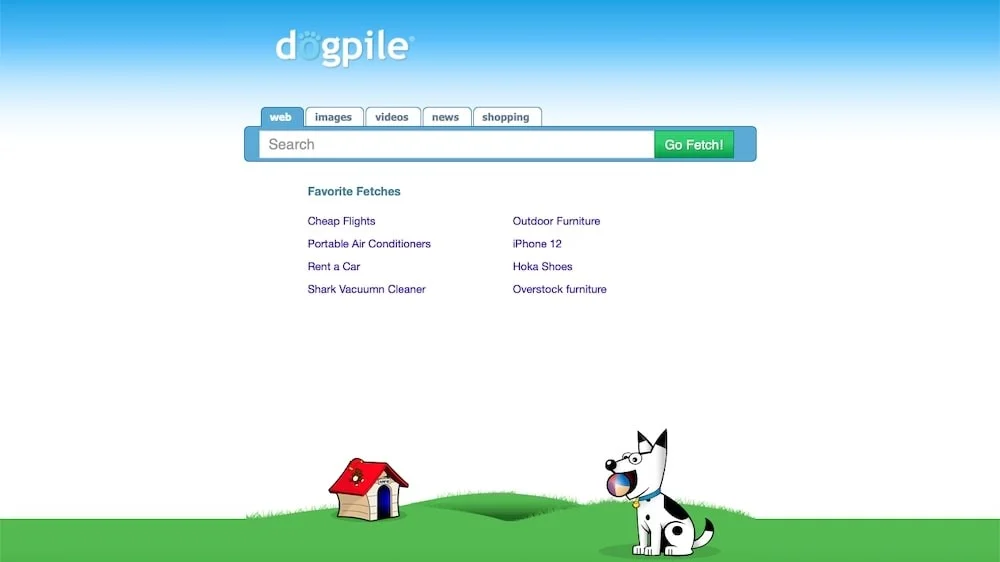
Useful for Unearthing Overlooked Content
Because it retrieves lower-ranking results from several engines, Dogpile sometimes surfaces older, niche, or region-specific content not shown on primary search engines.
Lightweight Alternative for Limited Resources
For users on outdated systems or limited networks, Dogpile is less taxing than full-featured engines. It’s an efficient fallback during outages or when using virtual machines.
Drawbacks and Limitations
Despite its strengths, Dogpile also comes with limitations that may impact its effectiveness in a professional or business workflow. Below are the primary issues to consider.
Stale or Delayed Results
Dogpile does not crawl its own data. It depends on other engines, sometimes leading to slower result refresh rates. Time-sensitive searches may be less effective here.
No Customization or Engine Prioritization
Unlike some meta-engines, Dogpile doesn’t allow users to prioritize specific sources. You can’t, for example, weight Google results more heavily than Bing.
Weak Advanced Search Support
The platform lacks advanced operators and refined filters. Queries involving logic operators, site-specific drilling, or date restrictions are harder to execute effectively.
Lack of Organic Search Results
After searching for something on Dogpile, you will usually be flooded with ads throughout the first few results. It takes some scrolling to find the actual organic results. Ironically, the search engine is popular for its organic results.
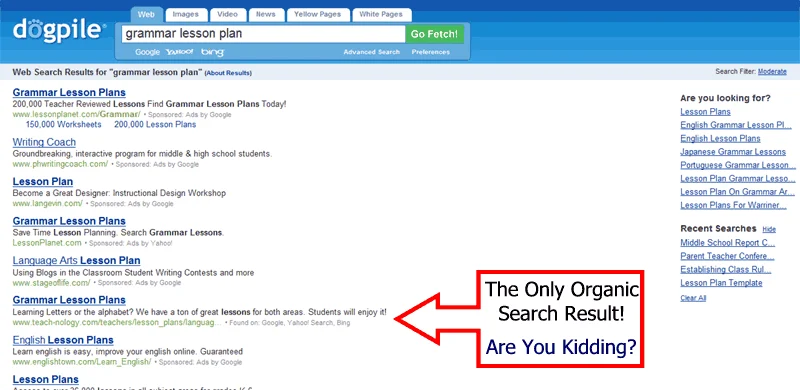
Source: Tech-nology
Poor Image and Video Search Functionality
Its multimedia capabilities are underwhelming. Visual content is not deeply indexed, and the result quality is inconsistent compared to direct search on Google or DuckDuckGo.
Privacy Trade-offs Still Exist
Though Dogpile advertises privacy, it is owned by System1, a company involved in data monetization. Business owners concerned with data protection should evaluate its privacy terms carefully before regular use.
Dogpile Search Engine Traffic and Engagement by Device: Is It Suited for SEO?
Evaluating Dogpile’s viability for SEO begins with understanding its traffic behavior. The platform’s user base is niche, with device preferences that skew the data significantly.
Roughly 57.95% of Dogpile traffic in 2025 comes from desktop devices, with only 42.05% from mobile. It contrasts sharply with Google and Bing, where mobile traffic often surpasses 60%.
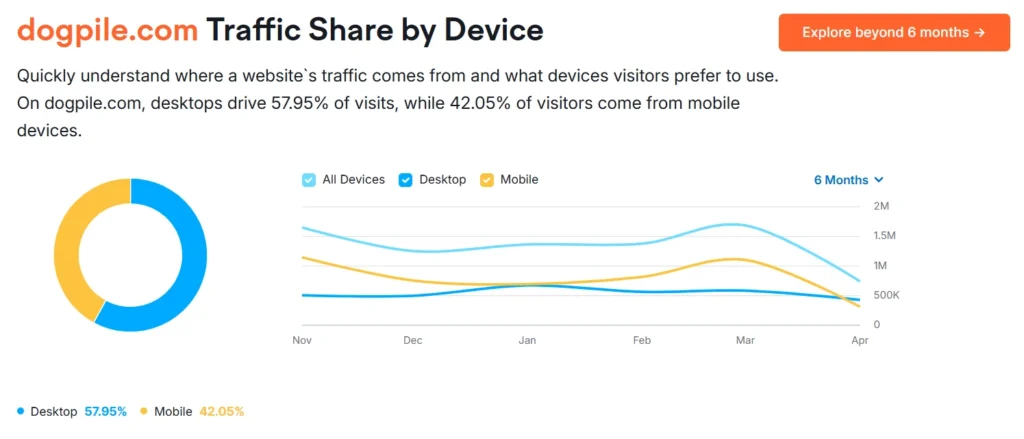
Source: SEMrush Dogpile Traffic and Backlink Overview
The implication is clear: Dogpile caters to legacy users, researchers, and professionals in controlled environments, such as labs, offices, or older systems.
Engagement metrics such as average session duration and bounce rate indicate moderate interest. However, the session depth is shallow. Most users view one or two pages before exiting, which aligns with utility-driven search patterns rather than exploratory browsing.
From an SEO standpoint, Dogpile is not a primary source of organic traffic. It does not host original content or produce its own rankings. Instead, it passes through results from other engines without SEO-specific snippets or structured data utilization.
Dogpile can’t influence domain authority or rank distribution directly. However, if Dogpile refers users from under-optimized sources or niche engines, it may serve as a weak auxiliary signal in digital footprints.
In short, it’s not irrelevant, but far from core to any serious SEO strategy in 2025.
Dogpile vs. Major Search Engines
Compared to Google, Bing, and DuckDuckGo, Dogpile is limited in index depth, real-time relevance, and user personalization. It lacks AI-powered summaries, integrated tools, or rich media previews.
However, Dogpile excels in offering unbiased, fast, and clutter-free results from multiple engines simultaneously. It’s ideal for secondary research, privacy-conscious lookups, and cross-validation of content visibility.
Major engines remain the priority for SEO, marketing, and competitive positioning. Dogpile, by contrast, supports supplementary verification or fallback use, especially when avoiding personalization bias is critical.
Who Should Use Dogpile Search Engine?
Dogpile appeals to a specific subset of users. It is not designed for the mass market or integrated digital strategies, but can effectively serve targeted workflows.
Independent researchers benefit from its ability to bypass personalized search bubbles and retrieve overlooked content. It’s also useful for IT professionals testing visibility across multiple engines quickly.
For business owners in industries like academia, journalism, or compliance, Dogpile can offer a quick baseline scan without triggering algorithmic weighting. It’s also a viable tool in regions with limited access to high-bandwidth.
However, Dogpile is unsuitable for modern marketing teams, data-heavy SEO operations, or mobile-first environments. It lacks APIs, analytics integration, and optimization insights that power today’s business dashboards.
Conclusion
Dogpile remains a relevant yet limited player in today’s search landscape. It doesn’t replace mainstream engines but offers unique value in specific use cases.
For business owners seeking broader search visibility or research support, it serves as a complementary asset rather than a competitive alternative to dominant search platforms.

